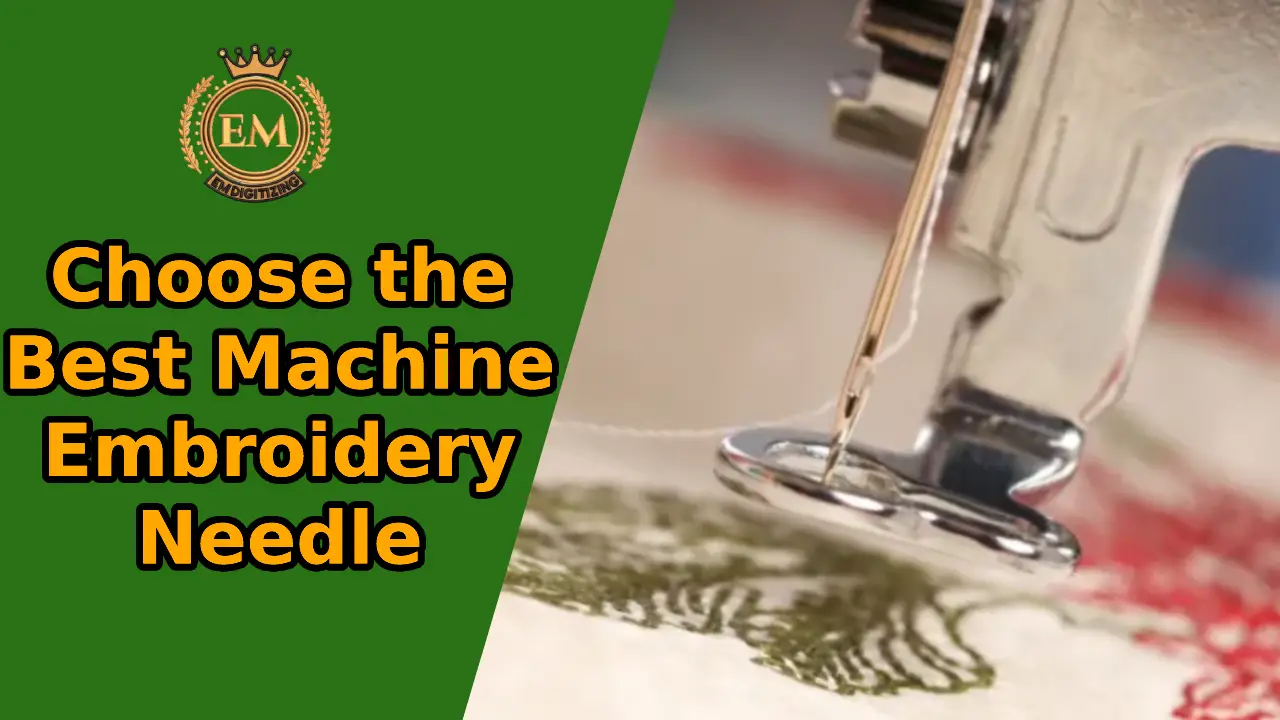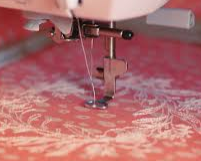
Considering the texture and density of the fabric, the type of stabilizer, and even the choice of thread, you can choose a needle that will help you sew beautiful embroidery designs.
So, why is the right needle important?
Because it’s as important as choosing the right embroidery material and moving your project forward in the right way! All of these small factors play a role in creating professionally crafted products that you would actually like to display or gift.
Embroidery Needle
The flat part on the top of the needle is called the shin and it is inserted into your machine, the flat part of which is towards the back.
This is followed by the shaft, which is the round part of the groove through which the thread travels.
This is followed by the eye of the needle, which is a small hole near the point of the needle, or its tip, through which the thread passes.
There is no picture of a small groove called a scarf, which allows the hook of the machine to lift the thread for sewing.
Difference between Sewing vs. Embroidery Machine Needle
At first glance, sewing needles and embroidery needles look very similar. But, if you look a little closer, you will see the difference. Sewing machine needles can be used for machine embroidery but embroidery needles are specially designed for maximum success in embroidery projects.
The embroidery needles have a long eye, a wide groove, and a special scarf to accommodate the embroidery thread. The big eye reduces friction with the thread, which reduces the breakage and fragmentation of the thread.
The main difference between a needle designed for an embroidery machine and a regular needle for a sewing machine is the size of the eye. Embroidered needles have larger eyes than allow the thread to pass through more easily. The small eye of a regular sewing machine needle can cause friction and snatch the thread if they are used for machine embroidery.
Embroidery Digitizing Services
Types of Embroidery Needles
When it comes to different types of embroidery needles, you will find chrome-plated needles and titanium-coated needles.
Chrome Plated Steel Needles
This is the most common type of needle material. In fact, this is the default needle material, so if the needle material is marked on the package, it is chrome. These needles can be used with most sewing and embroidery projects.
Titanium Plated Needles
These needles are of the highest quality. They are stronger, more durable, and less likely to heat up, bend or break during sewing your embroidery machine.
In addition, they have a coating that not only makes them last longer but also makes them less likely to fall on the material when you sew. If you are embroidering large designs or using hard or dense materials, then, under the hand, you may want to use titanium needles.
The SCHMETZ Gold Titanium needle finish is resistant to wear and heat, allowing the needle to slide easily through the adhesive with a slow adhesive construction.
The special Teflon-coated embroidery needles are called anti-glue needles! They are my favorite when I sew using adhesive, self-adhesive stabilizers, or with feasible nets. The needle is also good for embroidering on woven fabrics. This reduces the residue in the thread channel and in the eye.
Machine Embroidery Needle Sizes
Yes, like other sewing needles, embroidery needles come in different sizes! When referring to needle size, you refer to the needle’s width at the point. You will usually find two numbers for size: metric size and US size.
The 3 most commonly used sizes of machine embroidery needles are 75/11, 80/12, and 90/14 (not for home embroidery machines, but for commercial or multi-needle machines).
Size 75/11 is used for lightweight woven and woven fabrics, 80/12 is better for medium weight fabrics (such as quilts, cotton, and linen), and 90/14 embroidery on heavyweight fabrics. Good for (for example jeans and felt).
Needle Tip Shapes
Three different types of point shapes on machine embroidery needles are Universal, Sharp, and Ballpoint.
1. Fast
Sharp embroidery needles are the fastest and penetrate deep, woven fabrics. Sometimes water-soluble topping projects also require a sharp needle to pierce well.
2. Ballpoint
Ballpoint embroidery needles, on the other hand, have a round point that pushes the fibers of the woven fabric to one side instead of piercing and damaging them.
Sometimes it is difficult to find sharp and ballpoint embroidered needles, so you may be better off using a sewing needle.
3. Universal
Universal embroidery needles have a slightly rounded point located between the other two types. Thus, universal needles work well on woven fabrics and stretch woven fabrics.
Unless the embroidery needle package is otherwise specified, the most common machine embroidery needles are universal.
Unless your project explicitly requires otherwise (e.g., metal thread), start with a universal embroidery needle, which is the most common type.
Choose the Best Machine Embroidery Needle
Let’s go through the process of choosing a needle so you can learn to do it yourself!
1. Select the needle size
First of all, consider the material which you are going to embroider.
Thick and dense like wool or canvas? Start at 90/14.
Light or medium-weight quilts like cotton? Try 75/11.
Very light and delicate like vile, chiffon, or crepe? Maybe even 70/10 or 65/9.
No idea? 75/11 is a great place to start.
Second, check if your thread selection will work with the size of the needle. If it will not adjust the size.
Thicker threads (small wt numbers) require a thick needle with a large eye. For 30 wt threads, I like to size up to 80/12.
Thin thread (large wt) works best with thin needles and small eyes. Using 60 wt thread? With this 70/10 injection, your luck may improve.
Lastly, make sure the size of your needle will work with your embroidery design.
If sewing a very intricate, detailed design, consider a small, sharp needle that will make small needle holes more accurately.
2. Choose a needlepoint type.
First of all, think of the fabric that you will embroider.
Most stretched, woven fabrics work well with a ballpoint or universal. Most knitted fabrics work well with universal or sharp needles. This sharp needle may be needed to penetrate very thick, very thick fabrics (denim, canvas, vinyl).
If any confusion Try a universal embroidery needle first.
If an embroidery needle doesn’t work with your project, choose a sewing machine needle with a matching point. For example, metal threads and threads that glow in the dark require a top stitch or metal needle.
Generally, when using a sewing needle instead of an embroidery needle, start with the larger size of the sewing needle to ensure that the eye of the needle is large enough to adjust your embroidery thread without friction. Could do
Next, consider choosing your stabilizer. If you are using a water-soluble topping, and the universal needle is not puncturing, you may need a sharp needle.
3. Decide on the coating
Although there is no downside (other than the price) in using specially coated needles all the time, some examples require titanium or gold-coated needles.
I especially like coated needles when I’m embroidering on very thick, thick fabrics like denim or canvas, especially if I’m using a sticky, self-adhesive stabilizer.
Other Needle Troubleshooting Advice
- Before buying, read your user manual to determine if the needle shank will fit your machine. Most homes use embroidery machines that work with ordinary flat shanks, but some commercial machines use round shank needles. Also, some home embroidery machines recommend not embroidering with needles larger than 90/14.
- Change the needle repeatedly for proper sewing. Thread breakage or poor penetration can be caused by a bent, dim, or pointed needle. Everyone has a different idea about the proper time to change the needle, but I change my mind at least every 10 hours after active sewing.
- Store your needle in its original case or in the appropriate needle storage area if you need to take it out temporarily. That way you can remember what size and type of needle it was and you don’t have to worry about loosening it up by storing it loosely in a box with others.
Conclusion
I hope you have learned more about machine embroidery needles and how to choose the type and size that will produce the best results for your project.
If you are new to embroidery and you feel overwhelmed, be patient, and practice and you will soon find yourself embroidering like a professional!
The diameter of the needle you choose should always be equal to the width of the thread you will be using. For example, if the needle is too tight, the thread will not pass easily through the work cloth of the needle, which can damage the thread. This often leads to quarrels and terrible blurring.
Although both can be used for machine embroidery, the main difference between embroidery and sewing machine needles is the shape of the eye and the scarf. Machine-embroidered needles have an elongated eye and a specially shaped scarf that suits more delicate embroidery threads and does not allow them to break or ignite.
90/14 – Suitable for medium weight fabrics, such as lightweight cotton, polyester, linen, and lightweight upholstery fabric. Lightweight fabrics such as silk (chiffon, organza, crepe de chine) will require a smaller needle. The lighter the fabric, the smaller the needle will be needed.
Embroidery needles are usually slightly different from other types of sewing needles: the tip is less sharp, and the eye and the eyelet – (the small hole for the thread) is slightly larger. However, for special purposes, sewing needles are used for embroideries, such as for embroidery on leather or jeans.
Their sharp edges make them perfect for piercing tightly woven ground fabric and their slightly longer eye adjusts to embroidery threads of different weights.
